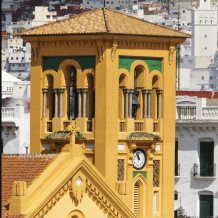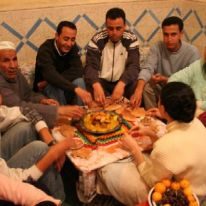Fes Morocco Travel Package, Haute Cuisine of Fes & Old City Discovery – Your Morocco Travel Guide
Fes is the perfect place for a Morocco Travel Vacation or a short break. Fes is a UNESCO World Heritage site and one of Morocco’s most traveled Imperial cities. Moroccan travelers visit Fes to discover Fassis heritage historical treasures and haute cuisine. The Guinness Book of World Records considers the University of Al-Karaouine Fes, Morocco the oldest continuously operating degree-granting university in the world.
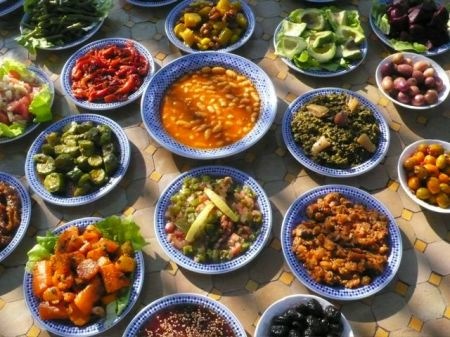
The city of Fes‘ cuisine offers rich and distinct flavors of traditional dishes such as Moroccan tagines, couscous, Pastilla (Moroccan Pigeon Pie), an mélange of carrot, eggplant and olive salads and the famous Moroccan soup called harira. Moroccan travelers who are looking discovering the culture of Fes should consider a Culinary Tour or ask Travel Exploration Morocco to arrange for a cooking lesson with a Riad and private chefs. Moroccan cuisine in Fes is prepared with a variety of herbs and spices that are grown locally within the region.

There are some dishes that are distinct to Fes. Traditionally combining a sweet flavor with a rich bitter bite. Dishes like mint and melon salad, choukchouka salad, zaalouk salad, feta, tagine, lemons, vegetable tagine, or a chilled radish, orange and fennel salad are often prepared into large courses. And of course, topped of with some Moroccan mint tea.
Fès is the fourth largest city in Morocco and also known as one of its most ancient Imperial Cities. Fes is separated into three parts, Fès el Bali (the old, walled city), Fès -Jdid (new Fes, home of the Mellah), and the Ville Nouvelle (the French-created, newest section of Fes. The Medina of Fès el Bali is believed to be the largest contiguous car-free urban area in the world.
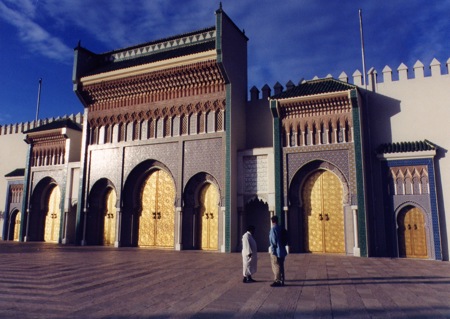
This award winning “Discover Fes” Morocco historical tour guarantees a (Book a Tour or call (800) 787-8806 spectacular Moroccan holiday.
DISCOVER FES MOROCCO – TRAVEL FOR 8 DAYS: MOROCCO HOLIDAY ITINERARY
DAY 1: CASABLANCA
►Arrive, settle in at your Casablanca hotel and rest for a few hours.
►Start your morning off with coffee and baguettes at one of the cafes at Parc de La Ligue Arabe, a huge garden with avenues lined with tall palm trees, ficus, arcades, pergolas and flowerbeds. Moving north, work your way up to the old medina as you move through Place Mohammed V and the Place des Nations Uniones, the main focal points of Ville Nouvelle, Casa’s new town. See French architecture complemented with Moorish design in Place Mohammed V, the protectorate square.
►Next enter Place des Nationes Unies. Now lined with impressive 1930’s apartments, shops and restaurants, the square was no more than an entertaining market place at the beginning of the 20th century.
►Make sure you have a camera in hand to take pictures of the famous clock tower, art deco hotels, the eleven stories Moretti apartment block and the high rise art deco buildings covered with loggias, columns, zellij tiles and geometric carvings on Boulevard Mohammed V.
►Visit the famous residential blocks: the Glaoui, the Bessonneau and the Asayag. The Boulevard links Place des Nationes with the railway station and is the gateway to the central market. Continue a short way to the Avenue des Forces Royal, a commercial area that leads into the old medina. With the help of your guide, move easily through the labyrinth of narrow streets lined with jewelers, barbers and artisans. See the squala, a fortified 18th century bastion. Visit the nearby shrine containing the tomb of Sidi Allal el-Kairouant, Casa’s first patron saint.
►Enjoy lunch at one of the international restaurants by Casa’s port, the Corniche.
►After lunch visit the Mosque of Hassan II. Casablanca is home to the Hassan II Mosque, designed by the French architect Michael Pinseau . It is situated on a promontory looking out to the Atlantic, which can be seen through a gigantic glass floor with room for 25,000 worshippers.
►A further 80,000 can be accommodated in the mosque’s courtyard. Its minaret is the world’s tallest at 210 meters. Casablanca’s Hassan II mosque building process began in 1980 and, was intended to be completed for the 60th birthday of the former Moroccan King , Hassan II, in 1989. However, the building was not inaugurated until 1993. Authorities spent an estimated $800 million in the construction of the building. It is an enormous architectural masterpiece and the second largest religious building in the world. Tour its famous minaret, dome, royal doors made of marble. On Fridays, the Mosque of Hassan II is open to non-Muslims.
The Mosque of Hassan II’s promontory offers lovely views overlooking Casa in the residential Afna quarter. After touring the Mosque, head over to the New Town of Casablanca also designed by the French architect Henri Prost for an hour of shopping.
► End the day with a visit to The Parc de la Ligue Arabe (formally called Lyautey) which is the city’s largest public park. On its edge is situated the Cathedrale du Sacre Coeur, which is disused, but is a splendid example of Mauresque architecture.
►Dinner at Rick’s Café, infamously known from the film, “Casablanca”
DAY 2: CASSABLANCA – FES
►Rise early, have breakfast in the Novelle of Casablanca and the take the road to Fès and arrive in the evening. Arrive in Fès in and settle in at your hotel.
►Enjoy dinner at your hotel or Le Maison Bleu, one of the most elegant Fassis restaurants with traditional music, and then prepare for next days tour.
►Spend the night in Fes at a traditional Moroccan Riad such as Palais Jamai or a Riad that is more intimate such as Ryad Myra.
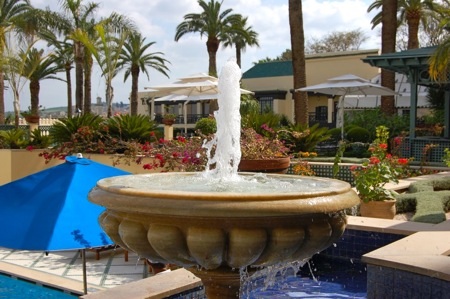
DAY 3: FES – MOROCCO’S HISTORIC LANDMARKS – MUSEUMS – MOSQUES
►After breakfast of Semolina bread, fruit, coffee and fresh squeezed orange juice; your day will begin at the Merenid Tombs of Fès.
►Standing among olive trees and blue agaves, the sixteenth century elegant ruins of marble and epitaphs face a breathtaking view of the Fès. Take a picture then continue along the old curtain wall of the medina and make a stop at the Musée des Armes, a fortress that once protected Fès.
►Next, enter the Fès el- Bali through the symmetrical horse shoe arches at Bab Boujeloud (The Blue Gate). Fès -el Bali, best characterized as a sea of rooftops embellished with minarets and domes, is too narrow for cars. Aside from walking, donkeys and mules are still the best way to travel within the cities old walls.

►Upon entering Rue Talaa Kebira, the main street in the medina, you will see lines of shops covered by canopies. Make your way to the Karaouiyine Mosque. Located in the Karaouiyine quarter, the Mosque is one of the oldest in the world and functioned as the first university in Morocco.
► After your visit, continue along the streets which will lead you to some of Fes’ most important buildings including Dar el- Magana, a fourteenth century water clock and Zaouia el Tijaniya, containing the tomb of Ahmed el Tijani, who spread his infamous doctrine Tariqq el- Tijaniya (The Way) throughout Morocco.
►We will visit the Ech Cherabliyine Mosque (Mosque of the Slipper makers) then browse the surrounding lines of souks selling henna, slippers, caftans, silks, jewelry and spices crowded around the kissaria. Next visit the UNESCO recognized site, Fondouk el- Najjarine. Within the foundouk’s three floors is the Musée de Bois, which displays carved doors from the Bou Inania Medersa.
►For lunch we will eat within the medina at one of the fine Moroccan palace-restaurants that serves an extravaganza of mezas (small plates of food) common among Fassis tradition. The mezas that are often brought to your table prior to the large mid-day meal will be several of these: Choukchouka salad, Zaalouk salad, Carrots with Cumin Seed, raisin and orange salad, Cold radish, orange, and Fennel Salad. The mezas are traditionally followed by the main meal, which will include the option of, a: Lamb, Prune, and Date Tagine, a Chicken Tagine with Olives and Preserved Lemons or a Vegetable Tagine. For desert you will be served with fruit/ or local Moroccan pastries along with Mint Tea.
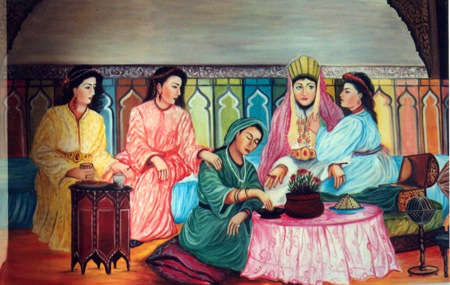
►After lunch we will visit the Musée Dar el- Batha to view the great collection of pottery, leather-work, wood, books and manuscripts from the nineteenth century.
► Next, enter Bab el Ftouh, the “Gateway of the Aperture” to explore the Andalusian quarter, a residential part of the medina laced with monuments. Experience the El- Sahrij Medersa and the Mausoleum of Sidi Bou Ghaleb. Our last part of the tour will take you into the Fès el Jedid, a Kasbah that functioned as Morocco’s administrative center until 1912. Explore the royal palace and many interesting quarters including the Moulay Abdalllah Quarter, the Mellah (Jewish Quarter) and a little farther down south lays Ville Nouvelle (The New Quarter).
Within the medina, we will the following historical sites:
►Medersa Bou Inania: An (Islamic school) founded by Abu Inan Faris that is highly decorated from floor to ceiling. The medersa is one of the few religious places in Morocco that is accessible to non-Islamic tourists.
►Kairaouine Mosque: Morocco’s second largest mosque was built by Fatima in 857. The Kairaouine Mosque became the home of the West’s first university and the world’s foremost center of learning at the beginning of the second millennium.
►University of Al-Karaouine: Founded in 859, this university is one of the leading spiritual and educational centers of the Muslim world and is considered the oldest continuously operating institution of higher learning in the world.
►Medersa el Attarin: A (Koranic school) that was named for local spice merchants known as attar. Founded by Sultan Abou Saïd in the 14th century as a students’ dormitory, it is attached to the Kairaouine Mosque.
►Zaouia Moulay Idriss II: A zaouia (shrine) dedicated to and the tomb of Moulay Idriss II, who ruled Morocco from 807 to 828 and founded the city of Fès for the second time in 810.
►Dar Batha: A Hispano-Moorish palace dating from the end of the 19th century that houses admirable collections of traditional art from Fès.
►Spend the night in Fes at a traditional Moroccan Riad.
DAY 4: FES – MOROCCO’S TOUR OF SOUKS – MARKETS
►After breakfast you will begin your guided tour of the souks and handicraft traditions in the medina, El Fès Bali, one of the world’s largest walled in cities.
►Every souk is reflected in the value of the items sold. The makers and sellers are grouped together according to the products that they offer and every type of craft has its own street or part of the street which is centered around the kissaria, near the Zaouia of Moulay Idriss. The layout of the souk is a complex network of streets selling luxury goods like fine silks and brocades, high quality kaftans and jewelry. There are also souks like the El-Attarine Souk selling spices, a slipper souk and a henna souk, which is set in a shaded area planted with arbuses.
We will visit the following places:
►Weavers Cooperative: We will also visit the Weavers Cooperative located in a residential neighborhood off a main shopping street. The workshop specializes in weaving the finest jellaba fabric, made of silk and wool threads imported from Italy. The shop also makes a quality jellaba fabric from locally spun, textured wool thread called hubba -sometimes referred to as couscous, because it’s nubby texture resembles Morocco’s national semolina dish of the same name.
►Berber Carpet Demonstration: The Famous Exhibition of Antique and Modern Carpets is one of the places in Fès el Bali where you can see a Berber carpet demonstration. You will be offered mint tea and follow your guide up a coil of stairs to a small area to watch carpets being made by young girls who come from the mountains to show tourists how Berber carpets are made.
►Tanneries: The Chourara or the Tanner’s Quarters is the most lively and picturesque souks in Fès. The Tanneries are often located near watercourses like the Wadi Fès and at a distance from residential areas due to the strongly unpleasant smells they produce.
►Dyers Market: The dyers market, located along Rue de Teinturies, is the best place to see the dying vats which have been used for centuries to soak the skins of sheep, goat, cows and camels after they have their hair and flesh removed is best seen from the neighboring terraces. You will see many tanned hides colored with natural pigments ranging from shades of brown, black, turquoise fuchsia, yellow and orange.
►Potter’s Cooperative: You will also visit the Potter’s Cooperative. Also known as Place el-Seffarine, this kisseria is the most important center for the production Fasiss style ceramics, brass-ware and silverware in Morocco.
►Spend the night in Fes at a traditional Moroccan Riad.
DAY 5: FES – VILLE NOUVELLE – NEW CITY
►After a breakfast of Moroccan sweet breads, fresh fruits and hot coffee drive to Ville Nouvelle, the new town dating from the French Protectorate that lies south of Fès el Bali.
►Originally the shopping center was designed to accommodate westerners living in Morocco; however, today it is considered to be a modern Moroccan city. There are five mosques within Ville Nouvelle that were built after Morocco became independent in 1956. Take a tour of the mosques and admire the attractive architecture and the buildings.
►Have lunch in one of the out door cafes in Ville Nouvelle then explore the shops in the new town. Ville Nouvelle has well stocked shops filled with Moroccan crafts and foods from all over Morocco plus European clothing styles. The square is especially known for having some of the best tailors in Morocco. On Lalla Miriem you can find handmade caftans, jallabas and gandouras of which you can have custom made for you or visit the local cooperative where all items have a fixed price.
►Dinner in the old Fes medina. Spend the night in Fes.
(Book a Tour or call (800) 787-8806)
DAY 6: FES – VOLUBULIS/ WALILI – MOULAY IDRISS
►After a traditional Moroccan breakfast travel on a two-hour excursion outside of Fès to explore the breathtaking archaeological site of Volubilis (Walili).
►Once occupied by the Romans, Volubilis has been recognized by UNESCO as a world heritage site and gained international acclaim when Martin Scorsese made it a feature location for his film, The Last Temptation of Christ.
►Begin your visit by discovering the fascinating Roman ruins adorned with beautiful mosaics and colorful tiles depicting Roman mythology. The ruins are spread out across several acres and what remain visible are several fragments of wall, parts of massive columns, the capitol, the basilica and a triumphal arch.
►You can view how the Roman Empire transformed the original Carthaginian settlement into a typical Roman city complete with mansions, a town center, a triumphal arc and temples devoted to the Roman gods. Volubilis once functioned as a final stop of the Roman imperial roads that went across France, Spain, down Morocco’s northern city of Tangier and eventually into Volubilis.
►Enjoy light fare for lunch at the small café that sits just below the Volubilis ruins.
►On the way back to Fes your driver will take you through the city of Moulay Idriss. You can stand on one of the twin hills of Moulay Idriss. From there you see a panoramic view and appreciate the green plateau upon which Volubilis is situated. The horizon is dominated by the triumphant aqueduct and from there you can see how the FertessaRiver, runs on one side of Volubilis, adding charm to the Roman ruins. Lunch on tajines and couscous and complement your meal with a glass of rose or red wine produced within the region.
►Every Muslim is supposed to make a journey to Haj at least once in their lifetime but five visits to Moulay Idriss equal one trip to Mecca. Explore the sacred town filled with defensive walls, a monumental gate, koranic schools, fountains and a new dome for the mausoleum. While the Tomb of Moulay Idriss is closed to non-Muslims, from the terrace near the Mosque of Sidi Abdallah el Hajjam, you can see breathtaking views of the town and the mausoleum. Before heading back to Fès sip coffee or mint tea on a terrace overlooking the rocky Middle Atlas Mountains.
►Spend the night in Fes at a traditional Moroccan Riad.
DAY 7: FES – MEKNES
►After a breakfast of fresh fruits, jams, bread and mint tea, begin your tour ofMeknes at Bab Mansour. We will take the road from Fès to Meknès.
►Often referred to as the Versailles of Morocco, Meknès is located between the fertile plain of Rharb and the Middle Atlas. The historical importance of Meknes is reflected in its grand Moorish buildings and in Meknes’ close relationship with Volubilis, a nearby city known as the most important archeological site in Morocco.
►Meknes rose to imperial status when Moulay Ismail began a building program to bring prestige to Meknes. Today, Meknès is the fifth largest city in Morocco and has a dynamic economic center that thrives on olives, wine and mint tea. The city’s unity of style lends it undeniable charm, enhanced still further by the beauty of the surrounding countryside. Come to Meknès and appreciate its beautiful gates, ramparts, mosques and palaces.
►Browse Rue de Souks, a street filled with hardware merchants (akarir), corn chandlers (bezzazine) and metalsmiths (haddadin). Also of interest may be a trip to the En-Nejjarine Mosque, a 12th century Almohad built structure. Before moving on to see the square towers and zellij tilework of the Bab el-Berdaïne gateway, catch the action of Ed-Dlala Kissaria. Every day in the Berber souk an auction takes place to sell carpets, blankets and other works made by the mountain dwellers.
►Lunch in the heart of the medina at Zitouna, a charming restaurant serving traditional Moroccan cuisine. After lunch continue the tour of Meknès in a Travel Exploration air-conditioned/heated 4×4. Explore Dar el-Kebira, a fortified quarter that is known as the imperial city. Dar el-Keibra is four times as large as the medina and has wide avenues and squares that are protected by a double line of walls and angled gates.
►Visit the palaces and mosques located within the heart of Ksar Dar el-Kebira, the heart of the Imperial city. Dar el-Keibra is also visited for the Mausoleum of Moulay Ismail. Featuring a suite of three rooms, twelve columns and a sanctuary hosting the tyrannical sultan, the tombs are reminiscent of the Saadian Tombs in Marrakesh.
►Return to Fes. Dinner at Le Palais D’Medina. Spend the night in Fes at a traditional Moroccan Riad.
DAY 8: FES – CASABLANCA
►Rise, have breakfast and departure from Fes. This ends your Morocco Travel experience.
Travel Exploration specializes in Morocco Travel. We provide Tours and travel opportunities to Morocco for the independent traveler and tailor-made tours for families and groups with a distinctly unique flavor. From Morocco’s Seven Imperial Cities, to the Magical Sahara Travel Exploration offers a captivating experience that will inspire you. At Travel Exploration we guarantee that you will discover the best of Morocco! Call Travel Exploration at 1 (800) 787-8806 or 1 (917)703-2078 and let’s book a tour to Morocco for you today
For more information about Morocco Travel to Fes
For more information about Travel and Tours to Morocco plus highlights on Moroccan culture visit Morocco’s Imperial Cities, Seaside Resorts,Sahara Desert, Berber villages, A Taste of Morocco, Magical Kasbahs, Ruins & Waterfalls, Absolute Morocco, The Best of Marrakech, Fes, and Ouarzazate.
Fes Morocco Travel, Fes Travel, Fes Tour, Fes Travel Agency, Fes Travel Itinerary, Fes Vacation, Fes Travel Tour, Fes Holiday, Fes Cuisine, Fes Medina Tour, Fes Guide to Morocco, Fes Culinary Tour, Fes UNESCO World Heritage Site, Fes Medina, Fes Riad, Fes Hotels, Fes Traditional Food, Morocco Travel, Tours to Morocco, Morocco Vacations, Morocco Holidays
Travel Exploration specializes in Morocco Travel. We provide Tours and travel opportunities to Morocco for the independent traveler and tailor-made tours for families and groups with a distinctly unique flavor. From Morocco’s Seven Imperial Cities, to the Magical Sahara Travel Exploration offers a captivating experience that will inspire you. At Travel Exploration we guarantee that you will discover the best of Morocco! Google on call Travel Exploration


